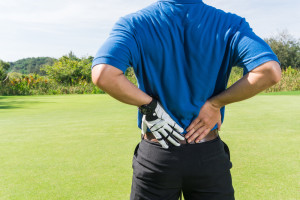 So far in this series of 3 articles we’ve looked in depth at shoulder injuries in golf and how to overcome them. We also looked at your low back and how the interaction between weak muscles and shortened muscles predisposes many golfers to injury, and at very least causes them to perform at a lower level than they could.
So far in this series of 3 articles we’ve looked in depth at shoulder injuries in golf and how to overcome them. We also looked at your low back and how the interaction between weak muscles and shortened muscles predisposes many golfers to injury, and at very least causes them to perform at a lower level than they could.
In this article we’re going to tie that together and introduce the concepts of balance and the body’s internal sense of where it is in space, then finish off by explaining how that will be helping or hindering your handicap.
What is Balance?
For our purposes, balance is the internal representation of your body’s position in space – your ability to stay upright in gravity. It is produced by your brain from several primary inputs:
Your visual system. This in turn depends on the ability of the eye to correctly see the world around you. So problems with the lens in your eye, along with your retina and nerves related to the eye will impact that. Similarly problems with your eye muscles can also change these inputs.
Your ears. The perception of sound is one component of balance, and issues with that can affect your brain’s ability to maintain balance. Through certain areas in the brain stem, the brain can triangulate the position of a source of sound, and can use that representation to judge whether the body is moving relative to the sound.
In addition, within the inner ear is the vestibular apparatus. These tiny structures sense head movement along linear/translational and rotational planes. So when you rotate your head to look over your shoulder, the vestibular apparatus detect that movement and notify your brain that movement has taken place.
Your proprioception. This is where we can help! Proprioception (from the Latin proprius – “one’s own”) is your brain’s understanding of where the components of your body are in space. For example, when planning to move your arms during a backswing your brain needs to know where your arms are in space to start with, as well as where they are along the way, so it can make corrections to the movement in order to make sure they end up in the right place.
Your proprioception uses receptors in your joints, tendons and muscles to generate that 3 dimensional picture within your brain of your body. The largest of those inputs comes from our muscles through receptors called muscle spindles. The muscle spindles in the arms during the swing stimulate pathways towards your spine through C5 to C8 vertebrae and up to your brain at 450 kph. The tone of our muscles has a direct impact on the quality of information that the muscle spindles are able to send to our brain and quality of information from brain to muscle. Furthermore, it is of great importance you know that the greatest concentration of these muscle spindles occur in the small muscles of the spine. They are instrumental in ALL movement.
Your Balance – So What?
Not withstanding that falls are one of the biggest causes of injury and death in any age group, poor balance can be compromising your performance on and off the golf course.
For example, when moving into your backswing your brain will be anticipating the shifts in weight that occur and making corrective movements to counteract you from being unbalanced during the swing.
In addition, the brain will be monitoring your movement to check whether those corrections are adequate, and if not, it will make further corrections. This is happening several times a second and is utilising reflexes known as vestibulospinal and vestibulo-ocular reflexes. From the top of the swing to impact with the ball there is not enough time to make drastic changes
This ability to maintain good body positioning is essential not just for staying balanced but also for developing a pure and powerful swing.
Through his work at Spine Scan, Perth chiropractor Dr Adam Rocchi ( chiropractor ) , frequently sees people with golf related injuries. The Trigenics treatment system focuses on the assessment and correction of muscle tone – the same tone that is important for muscle spindle receptor function and your body’s balance and power through the swing.
In our earlier articles on golf injuries, we described how muscle imbalance underlies most of those injuries. In fact, those same muscle imbalances are likely to be affecting your brain’s ability to balance the body during the swing. Using an adjusting tool known as the Pulstar instrument and the Trigenics system, Adam aims to identify and treat muscle imbalance and subsequently your brains function as well. If you’d like some help with improving your golf performance, please call the practice now on (08) 61508783 South Perth to arrange an appointment.


No comments yet.